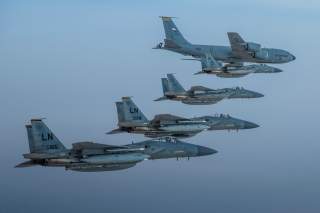How Iran Used Drones and Missiles to Stop 5% of the World's Oil Supply
The fact is that defending against these modern weapon systems can be tough—and the failure to be able to defend against them can be quite consequential.
There’s a lot of hand-wringing going on in defense circles across the globe over the increasing challenge of armed drones and cruise missiles, especially after the strike on Saudi oil facilities and oil fields earlier this month.
The fact is that defending against these modern weapon systems can be tough—and the failure to be able to defend against them can be quite consequential.
The Sept. 14 strike on the Abqaiq oil facility and Khurais oil field in Saudi Arabia—likely involving Iranian armed drones and cruise missiles—shut down 50% of Saudi Arabia’s oil production.
That’s 5% of global oil supply.
While it’s unclear exactly what happened in the attack at this point in the now international investigation, one thing seems clear: The armed drones and cruise missiles hit their marks unscathed.
How could that be, considering well-armed Saudi Arabia has a number of air- and missile-defense systems available to it to defend against armed drones and cruise missiles?
There are a lot of factors at play here, but one of the obvious challenges to successfully defending against the threat of armed drones and cruise missiles—regardless of who launches them—is the limitations on radars.
Cruise missiles and drones have some distinct advantages that make them uniquely appealing to military planners—and, in some cases, such as the attack on the Saudis, a weapon of choice.
First, drones and cruise missiles can fly low to the earth, hugging the terrain en route to their targets. That essentially allows drones and cruise missiles to “hide” in the topography, making it difficult for opposing ground-based radars to detect them.
Low-level flight can mask the attacker’s approach.
Second, these weapons systems, which are often smaller in size than larger conventional aircraft or ballistic missiles, are harder for radar systems to detect due to their smaller radar cross-section.
If you can’t see the target, you can’t shoot it down.
Third, cruise missiles and armed drones are often mobile, meaning the threat can come from any number of directions. Indeed, cruise missiles can be launched from the ground, from aircraft, and from ships and submerged submarines.
If radar isn’t pointed in the right direction at the right time, you won’t see the attack coming.
But armed drones and cruise missiles have disadvantages as well. One is that they aren’t invincible. Armed drones and cruise missiles have limited range and slower speeds, both of which can limit their effectiveness and increase their vulnerability.
They can be shot down.
Indeed, the Saudis claims to have shot down a number of armed drones (and seemingly, ballistic missiles) of the Iranian-backed Houthi rebels, launched into Saudi Arabia from Yemen during the ongoing conflict.
It’s possible that Saudi air-defense radars may well have been looking to the south toward Yemen, where the drone and missile threat was well-known—and not to the north toward the Persian Gulf, from which an attack wasn’t expected.
Armed drones and cruise missiles can effectively and efficiently augment a country’s air power and military might, and diversify the threat a potential opponent must defend against. The attack on the Saudis will only make these weapons systems more popular.
Without question, now would be a very good time for the U.S. to take stock of our armed drone and cruise-missile defenses.
As a senior fellow for national security affairs, Peter Brookes develops and communicates The Heritage Foundation's stance on foreign policy and national security affairs through media appearances, research, published articles, congressional testimony and speaking engagements.

